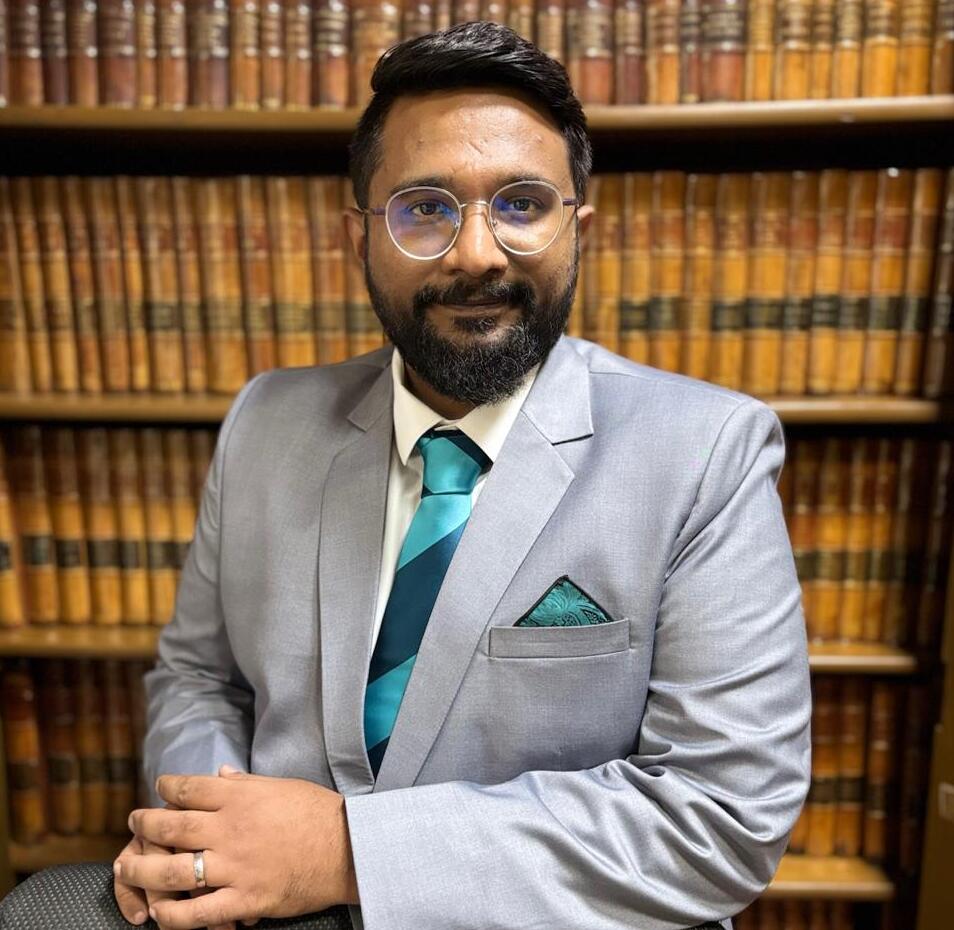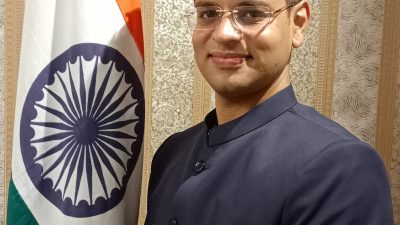Interviews
1961
0
0
“Litigation is not about instant gratification, it’s a slow build, where every draft, every appearance, every client interaction contributes to your growth.” – Mustafa Bohra, Associate Partner at Solomon & Co.
This interview was taken by SuperLawyer Team
Posted on April 24, 2025
This interview has been published by Anshi Mudgal and The SuperLawyer Team

Sir, your legal career spans a diverse array of practice areas, including criminal and civil litigation, writ petitions, and domestic arbitrations. Reflecting on your journey, what initially inspired you to pursue law as a career, and how did you cultivate expertise in such varied areas of law?
Looking back, my journey into law wasn’t driven by a single “aha” moment, but by a gradual and irresistible fascination towards it. What first drew my attention was my fascination with going to courts. There was something about the atmosphere, the energy and the way arguments unfolded, that captivated me from the start. Watching advocates argue complex matters with clarity and conviction inspired me to be part of this legal world. This fascination soon turned into a deeper interest towards law. What truly sealed it for me, though, was participating in several moot courts during law college. That’s where I for the first time experienced the thrill of legal research, strategy, and structured argument. Mooting gave me that rush, which made the law feel alive. It sparked a passion that’s been hard to resist ever since.
One of the most valuable lessons I picked up early on was learning to argue a case from both sides. It not only strengthens your understanding of the law but teaches you empathy, critical thinking, and the ability to anticipate and respond. These skills are crucial in any type of litigation be it civil, criminal or arbitration.
As for cultivating expertise across varied practice areas, there’s no shortcut. For me it’s been a deliberate process deeply rooted in constant reading and curiosity. I ensure that I not only read statutes and judgements but also apply those laws to hypothetical scenarios. It’s my way of pressure-testing the law and developing a deeper, more intuitive grasp of it. It sharpens interpretation, builds a nuanced understanding of law and prepares me to handle diverse cases with confidence. It also keeps me in a constant zone of learning, which is essential because the law is always evolving.
Can you share your journey from law school to the early years of practice? What challenges did you encounter when starting out in the legal profession, and how did you navigate those obstacles to establish yourself in your practice areas?
My journey from law college to the profession has been shaped by discipline, resilience, and a relentless desire to carve my own space in the legal world. Being a first generation lawyer, I come from a background where nothing was handed on a silver platter and from day one, I knew I had to work harder than most if I wanted to make it in the legal world and the journey still continues.
While studying law in college, I worked part time as a Karate instructor, juggling classes, internships and training. Balancing all this meant my days often started well before sunrise and ended well past midnight, but the discipline taught me how to manage time, stay grounded and never lose sight of my goals.
Before I formally entered the profession, I had already completed approximately three years of internships with a litigator because I wanted to be as ready as possible when the first opportunity came, and it eventually did, I was selected at Solomon & Co., a place that has shaped me significantly and allowed me to grow in arbitration, civil and criminal litigation. The principle which I followed as a student and an intern continued at the firm as well which was to never say no to any work. Even when a task or assignment felt beyond my comfort zone, I saw it as a chance to grow.
What I have learned is that success in law doesn’t come easy and certainly doesn’t come from shortcuts, it comes from showing up everyday, putting in the work and being willing to learn, unlearn and grow. I still carry the same hunger today, and I believe that as long as that fire burns, the journey will remain exciting.
Your career at Solomon & Co. has been marked by impressive growth, from Associate to Senior Associate, and now Associate Partner. What were the key milestones, accomplishments, or lessons that have contributed to your rise within the firm? How do you view your current role as an Associate Partner in shaping your long-term goals and aspirations within the firm?
My journey at Solomon & Co. has been defined by consistent growth, strong mentorship of my seniors and a deep-rooted passion for dispute resolution. From joining as an Associate to now working as an Associate Partner, every step has brought with it new challenges, learnings and opportunities that shaped me both professionally and personally.
Some of the key milestones in this journey include handling high stakes litigation, managing and nurturing a diverse team, and successfully building and maintaining client relationships. Each role I have taken on has reinforced the value of strategic thinking, clear communication and adaptability. These skills are fundamental for navigating the dynamic world of dispute resolution.
As an Associate Partner, my focus has expanded to including mentoring junior team members, broadening our practice areas, and actively participating in business development initiatives. It’s a role that demands not just legal acumen but also vision, patience and leadership and the same also aligns perfectly with my long-term goal of contributing meaningfully to the firm’s legacy, while continuously evolving into a well – rounded leader.
I am especially grateful for the trust and responsibility placed in me by Solomon & Co. and particularly by Mr. Aaron Solomon, our Managing Partner and other Partners at Solomon & Co with whom I have worked, their mentorship and support have played a pivotal role in my growth. The learnings and trust reposed by the firm helps me and continues to motivate me while raising the standards of work in my team and across practice areas ensuring the best possible client service.
The road ahead is exciting, and I look forward to continuing to grow with Solomon & Co. while making a lasting impact in the field of litigation and dispute resolution.
With your extensive experience in domestic arbitration, what do you consider to be the key elements for a successful arbitration process in India? How do you prepare for an arbitration hearing, and what are some common misconceptions clients have about arbitration that you make sure to clarify for them?
With the evolution of arbitration law and practice in India, a successful domestic arbitration hinges on a few key elements.
First and foremost, clarity in the arbitration agreement is essential. Many disputes begin with ambiguities in the arbitration clause itself, be it the seat, governing law, or the process for appointment of arbitrators. A well drafted arbitration clause reduces the scope for preliminary procedural challenges and delay.
Secondly, efficiency and preparedness are critical. Unlike court proceedings, arbitration gives parties greater control over timelines and procedure. To make the most of this, it’s important to have a focused strategy right from the statement of claim/defence stage, with clearly defined issues, timelines, and a vision of how the matter should proceed. When I prepare for an arbitration hearing, I focus not just on the legal merits but also on the narrative as to how to present a case in a concise and persuasive manner. Understanding the tribunal’s style and anticipating procedural objections or evidentiary challenges are all part of the preparation. Arbitration is often document – heavy, so organizing the record meticulously and preparing a tight chronology helps the tribunal follow the case seamlessly.
As for client expectations, one common misconception is that arbitration is always faster and cheaper than litigation. While it often is, especially when managed well, that’s not universally true. I also find that clients sometimes think arbitration is informal or less serious whereas in reality, it can be just as rigorous and adversarial, especially in complex commercial matters.
Another myth is that the arbitrator will find a middle ground to resolve the dispute. I always clarify that arbitrators are bound by law and evidence, and their role is adjudicatory, not conciliatory. Ultimately, the goal is to demystify the process for clients, set realistic expectations, and execute the strategy with precision and integrity.
You regularly appear before various judicial and quasi-judicial forums, including Magistrate Courts and the Bombay High Court. How do you adapt your legal strategies to suit the procedural differences in these distinct forums?
Each forum whether it is the Magistrate’s Court or a quasi-judicial tribunal, or the Bombay High Court has its own procedural framework, pace, and expectations. Adapting legal strategy to suit these differences is not just important but also essential for effective advocacy. In Magistrate Courts, proceedings tend to be more procedural, and form driven. The focus is often on compliance with statutory timelines, procedural filings, and the careful presentation of evidence especially in criminal complaints or cases under the Negotiable Instruments Act. Here, precision in pleadings, attention to procedural nuances, and consistent follow-up are key. Oral arguments are usually brief and factual, and the focus is on moving the matter through its procedural stages efficiently.
In contrast, when appearing before the Bombay High Court, especially on the original side, the approach is significantly different. Matters here involve a broader canvas such as complex commercial disputes, writs, appeals etc., requiring deeper legal analysis, structured submissions, and often layered case law support. Strategy here includes anticipating judicial thinking, being well-versed with recent precedents, and presenting arguments with clarity and brevity to match the Court’s time constraints.
At the core of my approach is a simple principle: form must follow function. Strategy is tailored not only to the forum, but also the nature of relief sought, the urgency involved and the profile of the adjudicator. One size never fits all.
As an experienced litigator who frequently handles high-profile cases, could you share a particularly complex or high-stakes litigation that you’ve managed? What were the main challenges involved, and how did you craft a successful strategy for your client?
One of the more complex matters I have handled involved representing a landowner, where we are defending a Suit and connected litigation concerning a large-scale redevelopment project in Mumbai. The dispute revolves around the ownership of land and other issues.
The main challenge lay in the multi – forum nature of the dispute: while the core issue is being adjudicated by the Suit Court, there are parallel proceedings before Magistrate’s Court, Deputy Registrar of Co-operative Societies, Land Revenue Officers etc.
Given the commercial and reputational stakes, the pressure to act swiftly and strategically was high. My approach was to first disentangle the overlapping legal issues and create a unified litigation roadmap. I worked closely with the client to identify his core priorities, staying adverse enforcement actions etc.
We focused on defending the grant of ad-interim reliefs from the High Court, which set the tone of the rest of the proceedings. What is important is a mix of legal precision and tactical patience. We avoided combative stance where unnecessary and instead leveraged procedural opportunities to bring the other side to the table for Mediation.
Cases like this reaffirm that high stakes litigation isn’t about winning, its about knowing when to push and when to pause.
With your wealth of experience across multiple areas of law, you are in a unique position to guide aspiring legal professionals. What advice would you offer to law students and young lawyers, particularly those looking to build a successful career in dispute resolution? Are there any key skills, resources, or strategies that you believe are essential for success in this field?
Dispute resolution is a deeply rewarding field, but it demands patience, precision, and perseverance. For law students and young lawyers aspiring to build a career in this area, my first piece of advice would be: embrace the grind. Litigation is not about instant gratification, it’s a slow build, where every draft, every appearance, every client interaction contributes to your growth.
Foundational skills like legal research, drafting, and court etiquette are non-negotiable. The ability to think analytically, anticipating judicial thinking, communicate clearly, and adapt to different forums is what makes a good Advocate. Early on, focus on understanding procedural law, it’s the spine of litigation. You may know the law, but if you don’t know how to apply it procedurally, you’re at a disadvantage.
I also encourage young professionals to observe courtroom proceedings, even when they’re not arguing. There’s no better classroom than a courtroom. Watch how seasoned counsel frame their submissions, how judges respond, and how strategies shift in real time. Over time, this exposure will shape your own courtroom style.
In terms of resources, commentaries, live cases, and judgments are vital but so are podcasts, lectures, and articles that give you practical insights. Law is no longer just about black-letter rules; it’s about staying curious, current, and commercially aware.
One underrated skill is client management. Understanding your client’s priorities, maintaining transparency, and managing expectations are as important as your legal strategy. After all, dispute resolution isn’t just about fighting, it’s about solving.
Finally, build your credibility. That comes from consistency, honesty, and being dependable not just with seniors or clients, but with your team as well. Reputation in this field is earned slowly. If you’re willing to put in the hours, keep learning, and stay grounded, dispute resolution offers you a career of intellectual challenge and professional impact.
Achieving a work-life balance in a demanding profession like law can be challenging. Given the pressures of high-stakes litigation and various professional commitments, how have you managed to maintain a balance between your career and personal life?
Work – life balance in the legal profession is a constant work in progress, especially in litigation, where the unpredictability of court dates, client emergencies and deadlines often spill over into personal time. I haven’t cracked it yet, but over the years, I have learned to manage the chaos.
What has helped me the most is being fully present wherever I am. When I’m in court or working on a case, I give it my undivided attention. But once I step away from that space, I consciously switch off, even if it’s just for a short walk, dinner date or watching one episode of a show on any OTT platform. Those moments of disconnection actually recharge me and help me return to work with better focus.
I have also learned the value of prioritizing ruthlessly. Delegation, trusting my team and setting realistic expectations have been key to avoiding burnout. Spending time with loved ones, traveling when possible and pursuing personal interest keeps me grounded. They are essential for mental clarity and long – term sustainability in a profession that can be all consuming.
Most importantly, I have realised that the balance isn’t about spending equal time, its about being aligned with what matters most in each moment. Some weeks will tilt towards work and others towards personal time. As long as I don’t lose sight of the people and passions outside the profession, it all evens out in the long run.
Get in touch with Mustafa Bohra –







No comments yet
Be the first to share your thoughts about this interview.